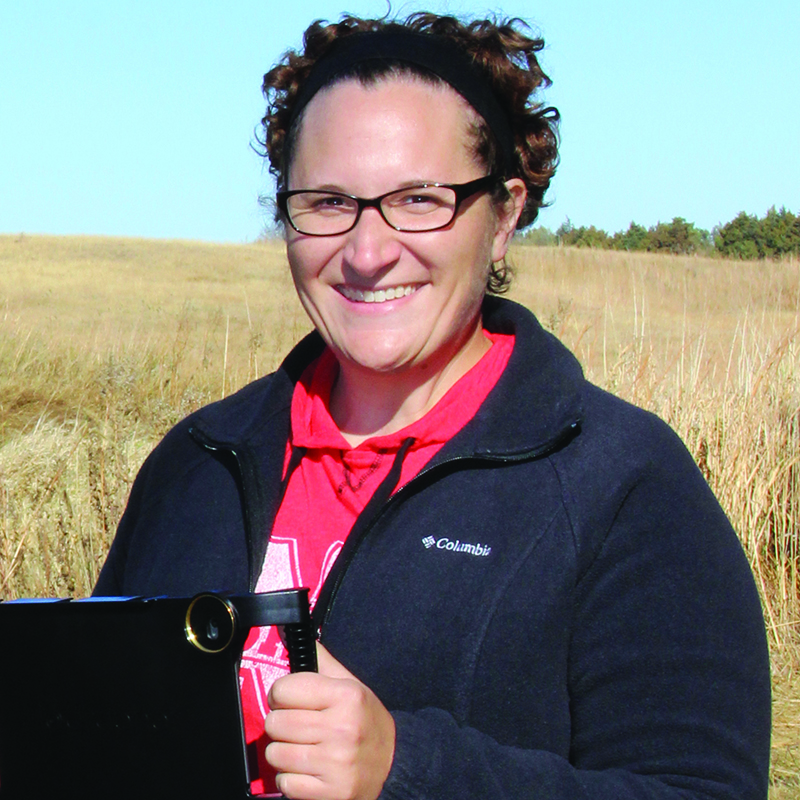
Streaming Science Creates Interest in Stem Career
new online program brings education opportunities to schools
Few people ever go inside a wind turbine. But through video technology, students throughout Nebraska saw the inside of one of these massive machines and learned from a Nebraska Extension educator how electricity is generated from the wind.
Jamie Loizzo created Streaming Science, an undergraduate student-driven project-based learning science literacy program, to help educate students at the university level about communicating science to younger students and create the fascination with science that compels them to become scientists themselves.
Loizzo was an assistant professor of agricultural and environmental sciences communication at the University of Nebraska–Lincoln until the summer of 2018, when she moved to the University of Florida to take a position as assistant professor of agricultural communications.
Loizzo and University of Nebraska–Lincoln students conducted the background research, captured video interviews with university scientists, then took the science to hundreds of Nebraska schoolchildren through live web-streamed electronic field trips, podcasts, photo essays and videos extended to audiences through websites.
“My role is to work with Extension to get kids interested in science, and to get them to want to be the next scientists,” Loizzo said.
STREAMING SCIENCE
Loizzo piloted classes in 2015, but Streaming Science officially started in 2016. Loizzo said several classes focused on topic themes such as “The Science of Food,” in conjunction with Nebraska Extension educators; “Big Data,” with the university’s Quantitative Life Sciences Initiative; “Ag Econ,” with the university’s Department of Agricultural Economics; “The Science of Corn,” with the Nebraska Corn Board; and “Women in STEM,” with the ADVANCE program. The ADVANCE program began in 2008 as a National Science Foundation grant-funded project and now has been folded into the university’s academic structure. ADVANCE recognizes that the country’s future requires talented men and women in science, technology, engineering and mathematics fields.
Streaming Science partners with Nebraska Extension specialists and educators to introduce topics to the classes. Loizzo and her students also reach out to scientists within the College of Agricultural Sciences and Natural Resources for their expertise, but also work with scientists outside of the college and the university.
ELECTRONIC FIELD TRIPS
With Streaming Science, Loizzo introduced a new way of learning: mobile electronic field trips. According to Loizzo, an electronic field trip is a two-way, live webcast that is produced and recorded on one end and watched by an audience on the other. The field trips are recorded using mobile devices, such as iPads and video cameras. They are recorded on location and streamed to middle and high schools across the state. While students watch the live stream, they can type questions into the streaming website for the scientists to answer. With this new model of teaching, teachers and students can access educational experiences that otherwise wouldn’t be possible.
Loizzo and her team of graduate and undergraduate students have put together two electronic field trips in the past: the Ranches, Rivers and Rats field trip was piloted to seven schools across Nebraska in 2017.
In November of 2017, Loizzo launched the Sun Rays and Windy Days electronic field trip. This trip gave students a look into alternative energy production in Nebraska. A Nebraska Extension specialist led the field trip and taught students about wind turbines and solar panels; the university students worked with the Extension specialist to capture video inside the turbine. The field trip was broadcast to 275 students across Nebraska.
The Ranches, Rivers and Rats electronic field trip was funded by a Food for Health Collaboration Initiative grant. Loizzo partnered with Mary Harner, an associate professor of communication and biology at the University of Nebraska at Kearney. The field trip was in three 15-minute segments; Harner’s segment focused on water quality research in Nebraska. A ranch segment taught students about the Sandhills region of Nebraska and what happens on a working ranch. Keith Geluso, a professor of biology at the University of Nebraska at Kearney, presented a segment about kangaroo rats in the Sandhills and their shift in population due to climate change. Loizzo revisited this field trip in spring of 2018, reaching 17 schools and 800 students.
Loizzo believes her role as an educator is to help create the next generation of science communicators. Science communication is an area of study that has been increasing and Loizzo takes pride in taking scientific content and helping the world understand it.
According to Loizzo, “Science literacy is a thread that runs through everything we do.”